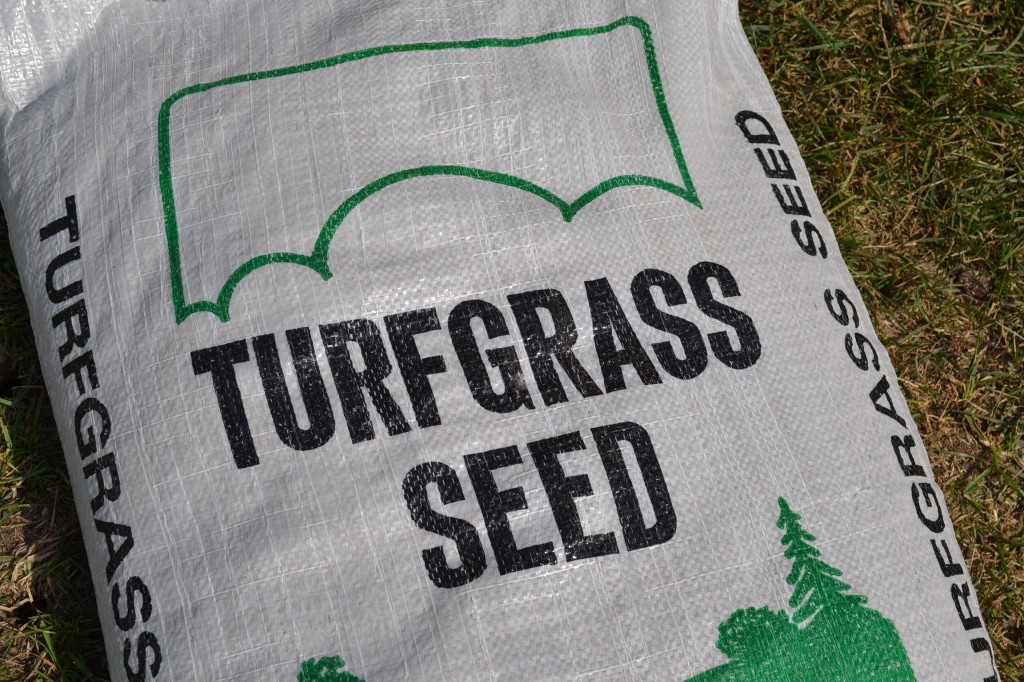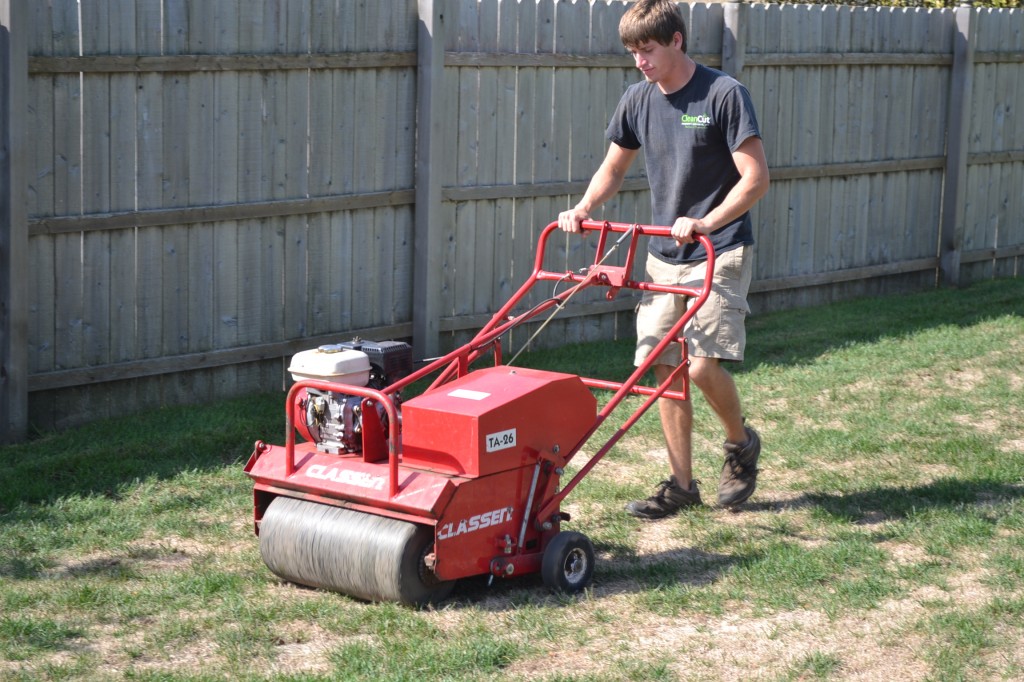Seeding is a great way to establish a new lawn or to repair damaged turf. Below are some great tips to help you get your yard established or improved.
Watering
New lawn seeding will require substantial watering to promote healthy growth. You will need to keep your soil moist so that the seed can adequately germinate. If you try seeding during the summer months with high temperatures and lack of moisture, you will have to water your new seed regularly. If you stop watering your seed after it germinates, your seed will die due to the lack of moisture. New seed does not have the deep root system that established grass has. The established grass can pull moisture from deep in the soil to meet its needs.
The key to successful seeding is to keep the first inch or two of the soil moist but not soaked.
Fertilizing
Any new lawn seeding will benefit from a starter fertilizer product such as a 13-13-13 or 10-10-10. A balanced mix of nitrogen, phosphorus, and potassium will promote root development and plant health. Micronutrient packs containing boron, copper, iron, manganese, molybdenum, zinc, nickel and chloride will improve new plant development. Fertilizing new seed should be done at a rate of roughly 3 to 4 pounds per 1,000 square feet. Read your product label for the proper application of the product that you are using.
New lawn seeding
Spring and fall are the optimal times to seed your lawn. Cooler temperatures with occasional rains provide the perfect growing conditions for seed. For spring seeding, we recommend planting after mid-April. Try to seed after all significant frost chances are out of the forecast. It may be necessary to supplement your seed with some watering of your own if mother nature does not provide enough moisture.
Fall seeding should be performed around mid-September. The reason being is that by mid-September cooler temperatures have moved into the area and usually consistent moisture returns. Most seed blends with Kentucky bluegrass will require at least a 30-day window with temperatures above 65 degrees Fahrenheit to germinate to their full potential. Most bluegrass seed will take about 2 to 5 weeks to germinate, so you want to leave plenty of time before winter to make sure that the seed germinates.
Fall turfgrass seeding is an integral part of helping fill in bare spots in your lawn. If you experienced drought die out during the summer, your yard probably needs some seeding work. Fall turfgrass seeding usually works best because of the cooler temperatures. In the fall there is generally more precipitation than in the summer. The ground tends to hold on to moisture longer in the fall because of the cooler temperatures.
If you are planning on doing some fall turfgrass seeding, keep in mind that some varieties of seed take longer to germinate than others. If you are seeding later in the fall, you might have to use a seed blend of rye or fescue. Rye and fescue seed varieties will germinate in about ten days instead of 30 days like bluegrass.
Pre-emergent products
If you are seeding in the spring, be aware that applying some pre-emergent weed control products to your lawn will affect the way your grass seed germinates or lack thereof. Many pre-emergent products will retard the seed germination process, giving you patchy germination. Products that contain Barricade or Dimension will hamper seed development. There is a product called “Siduron” that will allow seed germination while providing crabgrass control. This product typically lasts for four weeks, so it may need to be re-applied depending on the seed in your project.
Soil preparation
Proper preparation of the grass seeding area is vital in making sure that adequate establishment is made. You should prep your seed area by breaking up the soil that you are trying to plant on. Soil preparation can be done several ways. If you are seeding a small area, you can hand rake the soil or add additional topsoil to the area after planting. If you are seeding a larger area, tilling the ground with a garden tiller or tractor and gill might do the job. It is essential that the seed makes contact with the soil so that the seed can reach the nutrients that it needs to survive.
Once the area is prepped for seeding, you can apply the seed in several different ways depending on the area that you are seeding. If you are planting a small area, you may be able to spread the seed by throwing it down by hand. Larger areas may require the use of a slit seeder, spreader or tractor. After your seed is installed, you will need to work it into the soil. Soil preparation can be accomplished by hand raking the seed or using a tractor and rake depending on the size of your project.
Erosion control
Most larger projects require the use of erosion mat. We recommend installing straw mat, which is straw woven into the netting. This product can be rolled over the seeded area and staked down. Erosion mat helps increase seed establishment for two significant reasons. First, it holds the seed in place so that the seed does not wash away. Second, the straw mat holds moisture so that the grass seed requires less watering.
If installed properly at the right time, your grass seeding will turn into a lush and green lawn in no time.
Core aeration and slit seeding
Core aeration may be necessary, to ensure that the seed has contact with the soil. If your lawn is patchy, aeration and over-seeding is the best way to help get your lawn back into shape. Aeration should be done before seeding so that the seed will fall in the holes created by core aeration. If your grass is dead in sections, it may be necessary to rake out the dead areas or top-dress the areas with compost or soil.
Core aeration and overseeding– This process removes plugs of soil from your lawn. If you overseed after aeration, the seed will fall into the holes that were plugged. The dirt will eventually fill in over the seed.
Slit seeding– Slit seeding is performed with a slit seeder machine. The machine has metal tines that spin and plant the seed in the soil. Slit seeding helps ensure that the seed makes contact with the soil.
Hand raking– Hand raking is usually best for small areas. Start by raking the dead grass material out of the lawn. Once you have exposed the soil, break up the first inch or so with a shovel or rake. Install some seed into the ground and work it in with a rake.
Slit seeding in the fall can help thicken up a thin lawn. Patchiness or large dead areas may require slit seeding to help them fill back in. Slit seeding works great because it makes direct soil contact with the seed. Soil contact is one of the most important parts of seeding. Slit seeding ensures that the seed is planted in the soil and spaced evenly. This process also helps reduce wasted seed from an over application.
Slit Seeding tips for success.
- Make sure that your soil is moist but not wet. Moist soil will allow the slit seeder to insert the seed in the soil. The hard ground may keep the machine from adequately installing the seed.
- Make sure that your machine is set to the correct depth. If your machine is set too high, soil contact from the tines will not be made. If your machine is set too low, it may tear chunks of soil and grass.
- When slit seeding a large area, it is beneficial to run your machine in different directions to create cross planting. Running your machine in multiple directions will help reduce the look of cornrows and help build a thicker turf. You will use more seed when you cross plant, but it will provide you with a better end product.
- Fertilize your newly planted seed and water it in good to start the growth process.


